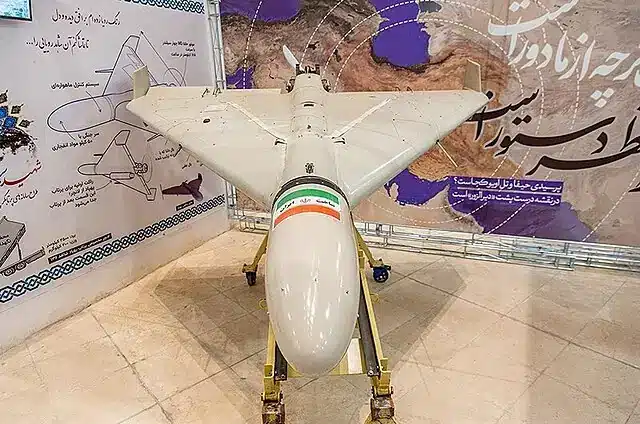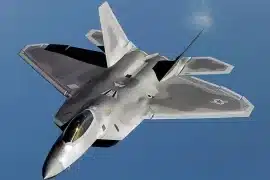The Shahed 136, known as the “Witness” in Persian, is an Iranian loitering munition, commonly referred to as a suicide drone. This drone, designed by Shahed Aviation Industries and produced by HESA, has gained notoriety for its role in recent conflicts, including its deployment against the Saudi oil plant in 2019 and its extensive use in the Russian-Ukrainian conflict of 2022. This article explores the key features, capabilities, and implications of the Shahed 136, shedding light on its role in modern warfare.
The Shahed 136’s Primary Role
The primary role of the Shahed 136 is to attack stationary ground targets with known coordinates. It can strike pre-set locations, making it less effective against moving targets. This specialization makes it a formidable tool for precision strikes on fixed installations, such as critical infrastructure.
Shehd 136: Design and Specifications
The Shahed 136 features a distinctive delta-wing shape, resembling a smaller counterpart, the Shahed 131. One notable difference lies in its wingtip stabilizers. Its propulsion system comprises a MADO MD-550 piston engine, which develops 50 horsepower. Interestingly, this engine is an Iranian copy of the German Limbach L550E. The engine is at the rear of the drone, propelling it forward at a maximum speed of around 185 km/h. While the exact range remains undisclosed, estimates vary from 1,000 km to 2,500 km. It has a flight ceiling of up to 4 km.
The Shahed 136 has a high-explosive fragmentation warhead, weighing between 36 to 50 kg. This warhead capacity surpasses that of a 155 mm artillery shell, highlighting its destructive potential.
Launch and Deployment
This drone is launched from a rack that can hold up to five of these loitering munitions. These racks can be installed on trucks, camouflaging the Shahed 136 in traveling order as a standard logistical vehicle with a canvas cover. The launch process involves a rocket-assisted takeoff, propelling the drone nearly horizontally toward its target.
Shahed 136: Components and Sanctions
Examinations of crashed and downed drones in Ukraine have revealed that the Shahed 136 incorporates components from Western and Chinese sources. Ukrainian reports indicate the use of a computer processor, possibly from the Altera Corporation in the USA, albeit without markings. This suggests Iran’s ability to circumvent sanctions and procure vital components for its drone program.
Navigation and Resilience
Notably, the Shahed 136 lacks remote control. Instead, it relies on a simple inertial navigation system coupled with a consumer-grade GPS system to reach its intended target. Operational use has revealed that this drone exhibits resilience against anti-drone rifles and electronic warfare systems.
Notable Deployments
In 2019, a swarm of 25 missiles and drones, including the Shahed 136, was reportedly launched from the Iranian Omidiyeh military base against a Saudi oil plant. While the Houthis initially claimed responsibility for the attack, UN investigators concluded that Iran executed it. This incident underscored the challenges Saudi Arabia’s air defenses face in countering such drone attacks.
Effectiveness and Cost
The Shahed 136’s effectiveness against military targets is limited due to its large size, slow speed, and noisy piston engine, often likened to the sound of a lawnmower or a moped. Ukrainian forces humorously nicknamed these drones “flying mopeds.” It can be detected from significant distances, potentially suggesting a design focus on civilian infrastructure rather than military targets.
Despite its limitations, the Shahed 136 remains a cost-effective tool for asymmetric warfare. Estimates of its unit price range from $20,000 to $50,000, a relatively small sum considering the substantial damage it can inflict on civilian infrastructure. Additionally, the cost of surface-to-air missiles required to intercept these drones exceeds the price of the drone itself, making them an attractive option for attackers seeking to overwhelm traditional air defense systems.
Shahed 136 Variants: Geran 2
Geran 2 is the Russian version of the Shahed 136. In 2022, Russia reportedly acquired at least 2,400 of these drones from Iran to meet an urgent operational requirement during the conflict in Ukraine. The Russian variant reportedly includes a built-in GLONASS satellite navigation system, enhancing its precision. While Ukrainian air defense systems claim to intercept 85% of these drones, some still manage to hit their intended targets, underscoring the threat posed by this loitering munition.
Summary of the Shahed 136
In conclusion, the Shahed 136 is one of the most powerful products of Iran’s drone industry. It represents a significant development in asymmetric warfare, enabling precision strikes on stationary ground targets. Despite its limitations in engaging moving targets and its distinct audible signature, this Iranian loitering munition has proven effective in various conflicts. Its affordability and the challenge it poses to traditional air defense systems make it a formidable weapon in the hands of those seeking to disrupt critical infrastructure and asymmetrical warfare tactics. Its adoption by Russia as the Geran 2 further underscores its significance in modern conflict scenarios. Russia has also received several Shahed-191 drones from Iran.








